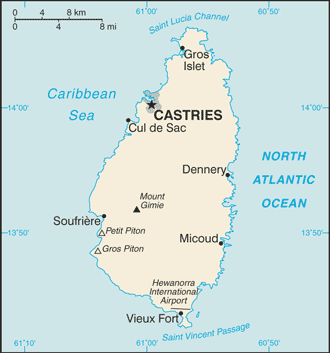America > Saint Lucia: Weather, Map, Costs and Travel Guide

Saint Lucia : When and where to go?
Click on a city for complete climate and weather tables
| Town | Jan | Feb | Mar | Apr | May | June | July | Aug | Sept | Oct | Nov | Dec |
| Castries |  |  |  |  |  |  |  |  |  |  |  |  |
Saint Lucia: Climate & Weather
St. Lucia reigns in a tropical climate, tempered by the trade winds.
The year can be divided into two seasons, one dry between January and May, the other rainy between June and December. On the temperature side, it is about 35 ° C from June to August, and around 27 ° C on average the rest of the time. Cyclones can occur between June and November.
The best season to visit the island is between January and May.
Weather today

Rain
Wind: 7 km/h
Precipitation forecast: 12,6 mm
> Full report and 7-days forecast
Data updated at 01:28 (local time)
At that time, the weather was:
 24 °C / Light Rain
24 °C / Light Rain
Saint Lucia: Map

Sponsored links
What to do in Saint Lucia
The island's beaches have a well-deserved reputation, especially on the West Coast, which is sheltered from the winds. To advise: on the west coast precisely, the beach from Reduit Beach to Rodney Bay, even if it is frequented; That of Causeway Beach, more calm; Pigean Island and Smugglers Cove to the north, which are more intimate; In the south, Saber Beach Wee Sha in Choiseul; That of Laborie, or that of white sand of Sandy Beach. To avoid, those on the East Coast that are more exposed to winds and whose currents are often dangerous.
The Petit Piton and the Gros Piton represent a unique site in the Caribbean, and are also a UNESCO World Heritage Site: they make up an exceptional landscape reflecting the volcanic origin of the island, Ocean, while lush vegetation surround them. On the coast, secret creeks and coconut trees, waterfalls and white sand complete this idyllic picture. See also in the same region, the petroglyphs of the 4th century BC. Left by the Amerindians at Stonefield Estate, near the village of Soufriere.
Traces of European settlement remain quite numerous, and you will admire the colonial houses such as those of Soufriere, or sugar cane plantations, still active to welcome tourists, but which have existed for more than 250 years and which used formerly African slaves.
Gros Islet is a quiet fishing village that rages on Friday night, where the streets are closed to traffic and where the music broadcasts music, reggae and calypso, to train locals and tourists in their wild rhythms. This is also the time to taste the culinary specialties that you will buy at every street corner, pork and barbecued chicken. You will find the same kind of atmosphere in Anse La Raye, in a little more calm.
Saint Lucia: The basics
The current currency is the Eastern Caribbean Dollar (EC $).
To reach St. Lucia, there are two airports, the largest in the south at Vieux Fort about sixty kilometers from Castries. Coming from France, you will stop in Martinique, but there are direct flights from Great Britain.
To move, the rental car seems to be a good solution (for rent in one of the two airports). Beware of road conditions and the carelessness of drivers. It is also mandatory to obtain a Saint Lucian driver's license. Taxis can be found very easily, but they are quite expensive. You can borrow without problem the minibuses which criss-cross all the roads of the island and which are very inexpensive.
The island offers several accommodation options, luxury hotels, cheap guesthouses, villas, but there are quite a few establishments at average prices. The most interesting is undoubtedly to rent a small villa to several. Allow about 60 € for a double room at the hotel. To eat, between 20 and 50 € per day in an average range but correct.
Health: there is no special precaution to be taken, but obviously it is necessary to protect oneself against the mosquitos, the risk of chikungunya being still present.
Safety: Avoid driving alone at night in isolated areas (snatching). As beaches are not monitored, be careful lots of your swimming. Listen to hurricane recommendations.
Shopping: you can take home souvenirs of perfumes with the scents of tropical flowers, dolls, costume jewelry, local straw and sisal basketry, fabrics.



